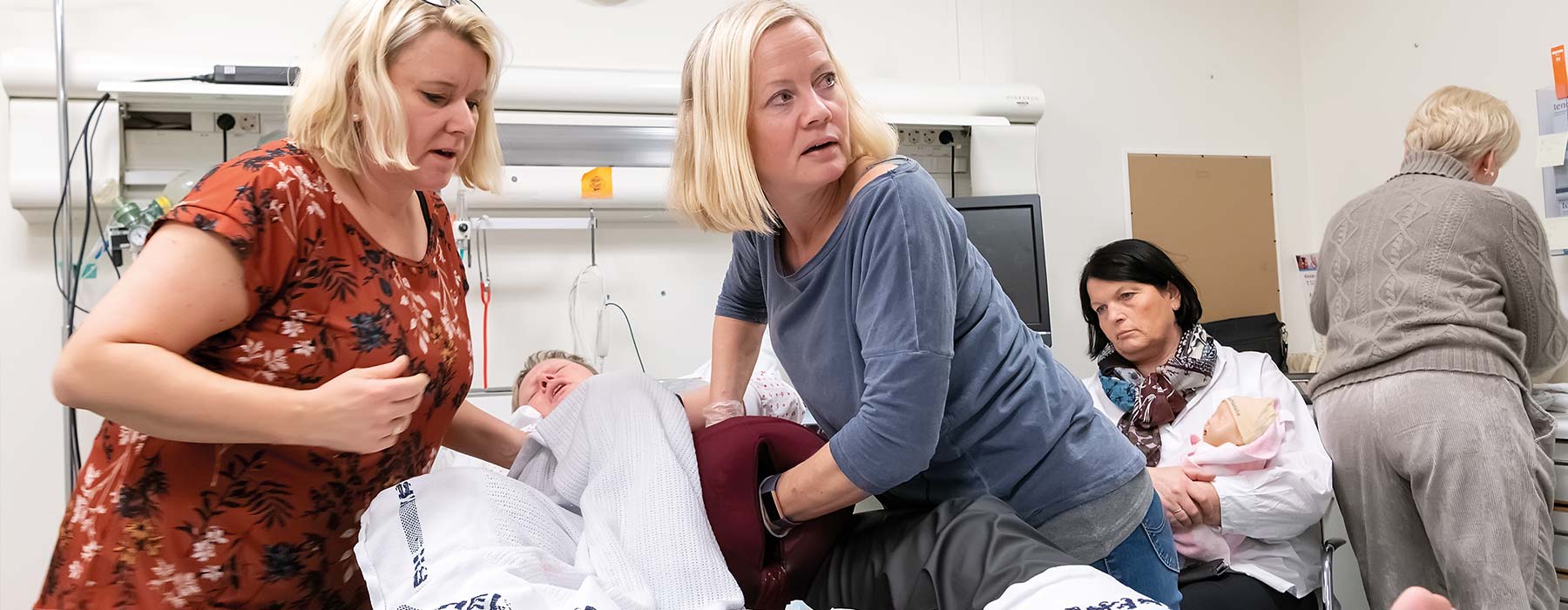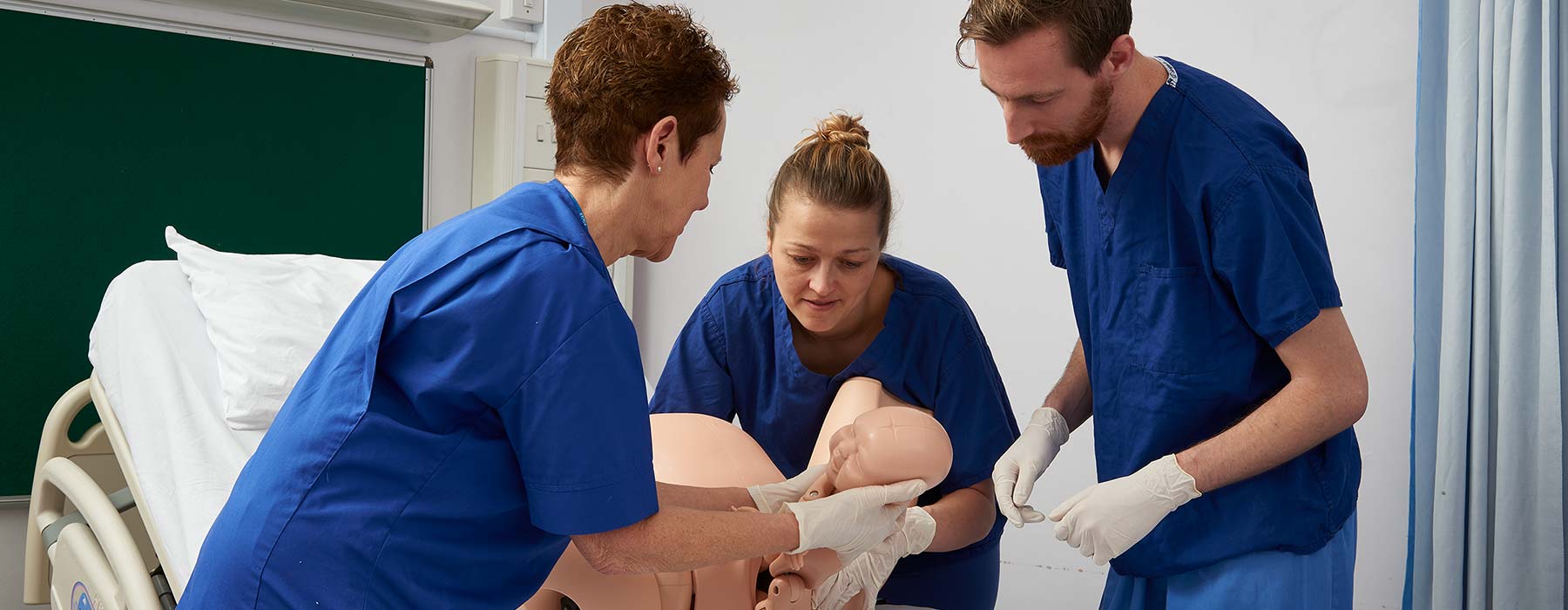The Joint Commission Perinatal Standards
Patient simulation can be your key to compliance.

Patient simulation can be your key to compliance.

As you may know, in 2021, the Joint Commission (TJC) began requiring hospitals to implement two new perinatal patient safety standards. There are important lifesaving fundamentals in TJC’s standards – standards that patient simulation can help facilitate, especially with regards to its emphasis on “drills.” Patient simulation can help you ensure compliance. At the same time, it can also foster continuous improvement. Studies show that simulation-based drills can correlate to improved patient outcomes1 and even help lead to lower malpractice claim rates.
In this article, we summarize TJC’s standards and the background on why they were updated. We also provide you with some insight into how simulation-based training can help you meet the TJC’s requirements for drills and position you for long-term continuous improvement. This article is intended primarily for those already working in simulation who are looking for more information on using simulation to comply with TJC standards. This article may also be helpful for anyone in Labor and Delivery who may need a quick resource on the topic.

Maternal mortality in the United States has been climbing over the last few decades.2 The U.S. maternal mortality rate in 2023 was 18.7 deaths per 100,000 births,3 compared to 10 deaths per 100,000 births in 1990.4 This means that the rate is almost double what it was 25 years ago.5
Rates of maternal deaths surged during the COVID-19 pandemic, but have since declined.6 According to provisional CDC data, 673 maternal deaths occurred in 2023.7 This is a decrease from 817 deaths in 2022 and 1,205 in 2021.8 However, the United States continues to have the highest rate of maternal deaths of any high-income country,9 and data shows massive disparities for women of color.10
The leading causes of maternal morbidity and mortality are hemorrhage and hypertensive disorders of pregnancy.11,12 Hemorrhage itself is the leading cause of maternal mortality worldwide.13 While hemorrhage can occur at any time during labor and delivery, it most commonly occurs postpartum and is defined by the term postpartum hemorrhage (PPH).
PPH is both common and incredibly dangerous, given how quickly a mother can bleed out. This is important in the context of structuring simulation drills. Labor and delivery teams need to recognize what’s happening, determine the cause, give medications, transfuse, resuscitate, and, if needed, transfer the patient to the operating room. PPH represents a radical change in the patient’s condition—and this a prime opportunity for simulation-based training.
Hypertensive disorders can also turn a patient case into an emergency. Identification of severe hypertensive disorders followed by rapid control by the labor and delivery team are essential—another area where patient simulation can help.
As an independent not-for-profit organization, TJC serves as the largest accrediting body for healthcare institutions in the United States. Hospitals certified by TJC are surveyed at least once every 3 years, and many hospital departments prepare for on-site visits far in advance.
TJC has been one of the leaders in highlighting a reality that has been the focus of patient safety advocates for years: communications failures are a leading contributing cause of patient harm.14 In a review of malpractice cases examined by CRICO Strategies, a research and analysis branch of the company that insures Harvard-affiliated hospitals and providers, communication failures were a factor in 36 percent of the cases.15
In 2019, TJC issued their requirement entitled, Provision of Care, Treatment, and Services Standards for Maternal Safety.16 TJC did this as part of their “Requirement, Rationale, Reference” or “R3” series, which TJC uses to express any newly-issued standards. In the maternal safety R3, TJC advises that hospitals use in situ training (training in the actual clinical environment) as a solution to meet their requirements. And commensurate with TJC’s emphasis on communications, TJC requires that drills include multidisciplinary teams. Human factors are consistently a TJC focus.

TJC expresses its requirement in the form of "drills" – in part so hospitals can test their systems. Here are the specific Provision of Care (PC) drill standards:
PC.06.01.01: Reduce the likelihood of harm related to maternal hemorrhage.
Conduct drills at least annually to determine system issues as part of ongoing quality improvement efforts. Drills include representation from each discipline identified in the organization’s hemorrhage response procedure and include a team debrief after the drill.
PC.06.03.01: Reduce the likelihood of harm related to maternal severe hypertension/preeclampsia.
Conduct drills at least annually to determine system issues as part of ongoing quality improvement efforts. Severe hypertension/preeclampsia drills include a team debrief.
Among the many benefits of using simulation to meet TJC’s drill requirements is that it creates a safe training environment where feedback on performance can be generated in real time and capturing data for use during a debrief is easy.
TJC does allow for other means to meet their drill requirements. But if you wish to make your drills reliable, consistent, and even mobile from place to place, simulation is an optimal solution. A patient simulator augmented by a video capture system and coupled with appropriate scenarios can deliver results that demonstrate compliance and uncover latent failures. And these same resources can be used going forward for continuous improvement efforts.
If you are someone who needs help or perhaps your organization does not have the requisite resources for simulation, Laerdal can fully support conducting simulations for you on site.
PC.06.01.01 and PC.06.03.01:
ACOG is an important influencer
If you are debating whether to use simulation to meet TJC’s requirements, you may be interested to know of the impact that the American College of Obstetricians and Gynecologists (ACOG) has made on the development of the requirements.
TJC referred to ACOG as its foundation for PC.06.01.01 and PC.06.03.01 – and ACOG is an advocate for simulation in this arena. Given widespread agreement that simulation improves outcomes in the setting of obstetric emergencies,17 ACOG has been consistently advising its members to use simulation.18 When TJC wrote its standards, it specifically referenced ACOG’s Committee Opinion No. 590: Preparing for Clinical Emergencies in Obstetrics and Gynecology, which specifically calls for the use of simulation as a means to improve care during labor and delivery emergencies.19

Perhaps for some, the biggest challenge in meeting TJC’s drill requirements will be the frequency of drills. Conducting drills annually is a minimum. But the true frequency will be determined by the hospitals’ assessment of proficiency.
The section below summarizes key areas where simulation has a clear role. You will gain additional benefit from simulation if you ensure that drills conducted throughout your organization – within a hospital or across a hospital system – are carried out the same way, capturing the same type of data, and meeting the same standards each time.
PC.06.01.01: Postpartum Hemorrhage
PC.06.03.01: Hypertensive Disorders*
Conduct drills at least annually to determine system issues as part of ongoing quality improvement efforts. Drills include representation from each discipline identified in the organization's hemorrhage response procedure and include a team debrief after the drill.
Note: This requirement is identical for PC.06.01.01: Postpartum Hemorrhage and PC.06.03.01: Hypertensive Disorders
Multidisciplinary drills give an organization the opportunity to practice skills and identify system issues in a controlled environment. It is crucial to involve members from as many disciplines identified in the organization's response procedure as possible. This is crucial for identifying weaknesses in the response system. A multidisciplinary approach will afford you the ability to test each level of an emergency and identify areas for improvement. Organizations should assess their level of proficiency to determine how often drills should be performed; organizations that have reached a high level of mastery may need less frequent drills.
Note: This requirement is identical for PC.06.01.01: Postpartum Hemorrhage PC.06.03.01: Hypertensive Disorders
Drills at least annually, preferably in situ
Goals:
Drill must include team debrief
Frequency is determined by hospitals' assessment of proficiency20
*Drills for Hypertensive Disorders do not require that the Hemorrhage team be present.
One of the greater challenges that an organization faces in the context of any training is maintaining a historical record. How does someone demonstrate that training during one period reflects the same standards as training from another period? Perhaps you have dealt with this. Personnel change, performance records may not be available – there can be any number of reasons for variation from time to time or place to place. A computer-driven, simulator-based experience eliminates many of those concerns.
In 2023, TJC released a Sentinel Event Alert: Eliminating Racial and ethnic disparities causing mortality and morbidity in pregnant and postpartum patients. It explores how to eliminate barriers and racial disparities that are causing mortality and morbidity in pregnant and postpartum patients.
According to the Sentinel Event Alert:21
Non-Hispanic Black people are 3 times more likely than white people to die of pregnancy-related causes
Native American pregnant patients are 2 times as likely to die than white pregnant patients
For Black pregnant patients with at least a college degree, the mortality rate is 5.2 times higher than that of their white counterparts
- TJC Sentinel Event Alert
TJC recommends several actions in the Alert. We list some of these recommendations below, and explain how simulation can help:

1. TJC recommendation: "Prepare for the possibility of hemorrhage and other complications. Maximize response efficiency by reducing the time spent and distance traveled to access supplies and medications necessary for postpartum hemorrhage treatment. Test and perfect your system to ensure quick response, especially access to blood."
How simulation can help
Running in situ simulation drills provides the opportunity to test your current system, identify inefficiencies, and then test and practice your solutions.
2. TJC recommendation: "Address unconscious biases of health care providers toward people of color through universal training."
How simulation can help
Simulation can provide a risk-free environment for your providers to practice caring for a diverse range of patients, helping to build their cultural competence.
3. TJC recommendation: "To reduce the high incidence of low-risk C-sections, provide education and training for the interdisciplinary team to develop knowledge and skills on approaches that maximize the likelihood of a vaginal birth, including assessment of labor, methods to promote labor progress, labor support, pain management (both pharmacologic and nonpharmacologic), and shared decision making."
How simulation can help
A birthing simulator gives providers hands-on, deliberate practice opportunities to train as a team in effectively managing deliveries reduce low-risk C-sections.
If you’re still struggling to meet TJC’s requirements, or you need to accelerate your efforts, here are some general tips to help.
Identify your goal and desired outcome
Create a statement of what you want to physically accomplish and by when. It can be as simple as "I must train X number of labor and delivery teams annually between Y and Z date."
Your desired outcome should be what you want participants to carry back to their roles and what you want the results of their performance to be.
Create an interdisciplinary team
Based on TJC standards, you should consider involving OB/GYN doctors and nurses from your Labor and Delivery Department, but also members from your anesthesia department, pharmacy, blood bank, and emergency response/code team. Using simulation for your drills will give them all a focal point to rally around.
Involve stakeholders
Simulation can be new to people, especially those in administration. Get them involved. Let them see a simulation and how teams respond during and after the experience. If you have to prove Return on Investment with stakeholders, you may want to consider reading our article, 7 Steps to Navigating the ROI Discussion: Making the Case for Medical Simulation.
Identify the protocols that are in place and that you must test
TJC’s drill requirements are that you not only enable staff to practice skills but that you also use the drills to determine system issues, test levels of emergency preparedness, and identify areas for continuous improvement - all with the right people present. Use the protocols - and hopefully the environment - that you have in place. Discuss whether you accomplished the goals outlined within those protocols during your debrief.
Involve quality and risk management
Healthcare facilities spend millions of dollars on quality and risk management efforts each year. And hospitals employ a significant number of people to shepherd quality and risk management programs. Simulation may be a new type of intervention for them. Involve them, and you may find a new level of support.

If you are involved in Labor and Delivery in any way, you work in one of the most consistently valued and needed areas of healthcare. Meeting TJC’s Perinatal Standards are an opportunity for you to use simulation in a way that can ensure your compliance and give you a new level of empowerment for your perinatal patient safety efforts going forward. Please let us know how we can help. Contact your Laerdal representative today.
Our mission at Laerdal is helping save lives. One of the ways we pursue that mission is to ensure that clients can use simulation-based training and education to prepare their staff to deliver the best possible patient outcomes regardless of the acuity of the case. Our goal is to help save an additional 1 million lives annually by the year 2030.
Sign up for Laerdal Medical email updates. You can identify your interests and receive new educational content, updates, event information and more.